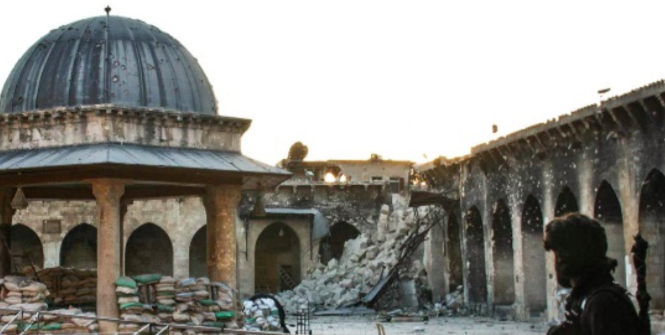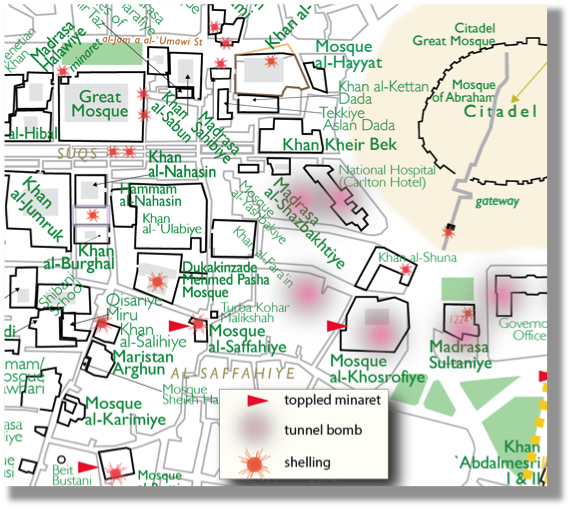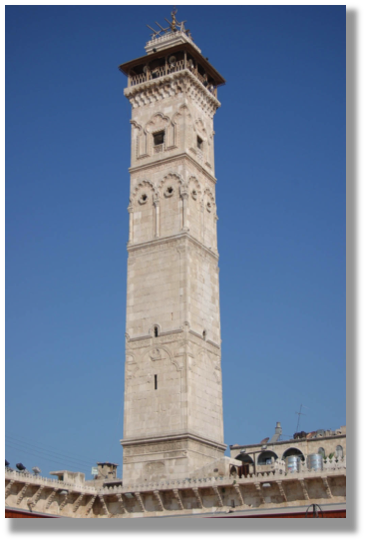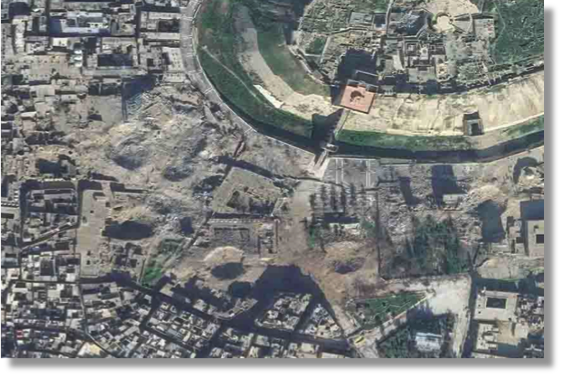Aleppo - Ground Zero of the Syrian Conflict

Syria’s ancient and medieval heritage has become another victim of the war, overwhelmed and often overlooked in the face of a vast human tragedy. Historian and former Ambassador in Syria Ross Burns counts the cost.
In 1992, the first edition of my survey of Syria’s archaeological sites, Monuments of Syria, an historical survey of all major sites or buildings, was published. This was the first such survey in English and came at a time of rising interest in the extraordinary range of Syria’s monuments. The book later went through two more editions, the last in 2009, just before the present crisis.
As the purpose of the work was to provide a readily available source to the curious visitor and to locals who were visiting in increasing numbers, I am pleased to say that the book rapidly became pirated. On subsequent visits to Syria, it was always gratifying to see local guides carrying very battered versions (sometimes just sheaves of photocopied pages) which they quoted from as if it were the Bible.
When the current crisis was in its early stages, I wanted to continue the task by providing visual evidence of the sites now that the fighting made it difficult for anyone to travel within Syria. I created a website which mimicked the book’s gazetteer and itineraries so that the text could be retraced in the imagination.
It quickly became apparent, too, that the monuments of Syria were becoming victims of the war. Though not on the scale of the massive destruction of lives and civilian property that was overwhelming the country, these losses too should be documented so I opened a new tab ‘Syria Conflict’ on the webpage. This has provided a cumulative list of the damage reported since the beginning of the crisis, updated each month. Virtually all of this material, it should be noted, came from the cameras of local Syrians who were concerned that Syria’s cultural assets should not be forgotten and posted numerous updates to websites such as the Association for the Protection of Syrian Archaeology. APSA’s role in documenting this aspect of the conflict has been invaluable.
In my view, however, if physical damage to monuments is assessed against the scale of the human tragedy which has swept over Syria, it is not a major element of the crisis whose implications are epoch-making in the longer tem. Over-reacting to instances of minor damage that could readily be repaired, for example, can be seen by suffering Syrians as outsiders’ insensitivity to the overwhelmingly desperate situation the country is now in. It can look as though outcries are only warranted when historical buildings are in danger, even if that is not the intention.
This is not intended to argue against international concern. Outrage, however, should be channeled constructively and assessed against facts. It is admirable that organisations such as UNESCO are doing what they can, particularly to provide the skills that might head off damage or will assist in reconstruction in the future.
My assessment of damage is based on visual material posted from within Syria. The current list includes 232 buildings or sites. Such material is assessed against my own experience, including extensive holdings of photos of many thousands of sites and buildings pre-April 2011. It does not reflect assertions in media reports unless these are backed by visual evidence. It also uses this evidence to evaluate critically frequent claims in various media of ‘destruction’ or ‘damage’ which in the context of a savage war is sadly often little more than the ‘wear and tear’ involved in exposure to the environment and to normal communal life or its breakdown. Archaeology itself is a form of destruction as it exposes previously protected material to the elements and to those intent on finding contraband. Opportunistic pilfering, occupation by refugees, small-scale illicit digging and illegal constructions are therefore not included unless instances reach epidemic level, as for example at Apamea where the integrity of the whole site has been compromised.
One objective of the website is to set the level of damage in the context of the longer term prospects for repair or reconstruction. Numerous media reports have described a building as ‘destroyed’ when in fact the damage is confined to a few stones on an upper battlement of a castle which has been designed to withstand the battering rams of a Saladin or the undermining of the Sasanians. It would take a huge bombardment over many weeks to bring significant damage to such structures, let alone ‘destroy’ them in a casual hit. One results of ‘crying wolf’ in such instances, is that people switch off when real losses happen.

A map of destruction and fighting in Old Aleppo. Photo Credit: Ross Burns.
The penalties of such exaggeration are clear in an examination of what has happened in the central historical area of Aleppo (above). Aleppo has suffered more heavily than any other city or site as the central monuments lie right on the frontline between the government forces and the various elements of the opposition. The regime has held on to the historical Citadel which towers over the zone occupied by the suqs, the Great Mosque and numerous other buildings of the Islamic periods. Snipers hide out in the minarets of this densely packed zone and can be readily spotted from the battlements of the Citadel, the most magnificent example of Islamic fortification techniques we have.

The now destroyed minaret at the Great Mosque in Aleppo. Photo Credit: Ross Burns.
In this crowded theatre of conflict it is difficult to assign blame for the worst destruction, but all must share in responsibility. The loss of the superb minaret (above, pre-2012) built for the Great Mosque in 1092, probably to regime shellfire from a tank or from the Citadel heights, toppled, in one or two blasts, a unique example of Seljuk architecture that filled in a long gap in the city’s record between the Islamic conquest and the Crusades. Many minarets have lost their upper structures, the fifteenth century suqs have been gutted by a fierce blaze touched off by shellfire, the Great Mosque itself is a burnt-out hulk.
The worst damage of all, however, results from the ‘tunnel bombs’ of the Islamist forces, mostly claimed by Islamic Front. The technique involved tunnelling under buildings, packing the cavity with huge quantities of explosives and setting a fuse. The result clearly is ‘destruction’ in every sense of the term. Usually nothing recognisable remains except a large bowl-shaped depression in the ground, a huge amount of scattered rubble and pulverised stone, much of which is carried off as a dust cloud.

Aerial Photo of the damage caused by tunnel bombs around the citadel in Aleppo.
In virtually all these cases in central Aleppo, little coverage has been given in the media, perhaps de-sensitised by reports of ‘destruction’ of buildings which have clearly continued to exist. In Aleppo’s case, they clearly haven’t survived, as satellite imagery confirms (Digital Globe photo above, courtesy of ASOR). It is hard to see how this destruction advances the Islamists’ agenda. They have destroyed, for example, sites that have been honoured for centuries, including the burial mosque of a son of Saladin, from the period of the Islamic resistance to the Crusades, and an early example of a mosque of the great Ottoman court architect, Sinan.
We may have to get used to the prospect that this conflict will go on for many more years. There is no dynamic in play which would see its early end, though it might morph from its present lines of confrontation into another series of conflicts, as recent events in southern Turkey demonstrate. Only after the dust of the conflict has settled can we realistically channel our outrage into a constructive response. For that purpose, information gathering is all-important in the present situation. We can rely too on the ingenuity and energy of the Syrians to apply the same skills as stone-cutters, engineers and conservers which have produced such impressive results in recent decades.
By my calculations, thirteen buildings in central Aleppo have been seriously damaged or have totally collapsed. Another 63 are in a state where repairs would be possible. I hate to think how many apartment blocks have been felled. Syria’s ancient and medieval heritage can largely be rebuilt but, like Germany after World War Two, the priority will have to be to rehouse the hundreds of thousands who will return to devastated homes and towns.
Ross Burns was Australian Ambassador in Syria 1984-87 and has published two works on the archaeology of that country. He is currently completing a history of Aleppo. He also runs a Syrian focused website, Monuments of Syria. This article can be republished with attribution under a Creative Commons Licence.


